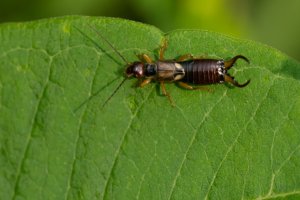Earwigs, also known as pincher bugs, are common garden pests known for their intimidating pincers and nocturnal habits. While they can be beneficial by feeding on other pests, an overabundance of earwigs can cause significant damage to plants and become a nuisance indoors. This comprehensive guide will explore effective methods to get rid of earwigs, prevent infestations, and maintain a healthy, pest-free environment.
Understanding Earwigs
Before diving into removal methods, it’s important to understand the nature and behavior of earwigs:
- Appearance: Earwigs are easily recognized by their elongated bodies, dark brown color, and prominent pincers at the rear.
- Behavior: Earwigs are nocturnal and tend to hide in dark, moist environments during the day. They feed on a variety of organic matter, including decaying plant material, other insects, and sometimes living plants.
- Habitat: They thrive in damp areas such as under mulch, leaf litter, and garden debris. Indoors, they seek out humid places like bathrooms, basements, and kitchens.
Prevention Methods
Preventing an earwig infestation is the first line of defense. Here are some effective preventive measures:
1. Reduce Moisture
Earwigs are attracted to moist environments. Reducing moisture around your home and garden can make these areas less inviting:
- Fix Leaks: Repair any leaking faucets, pipes, or air conditioning units.
- Improve Drainage: Ensure proper drainage in your garden to prevent water from pooling.
- Use Dehumidifiers: In damp indoor areas like basements and bathrooms, use dehumidifiers to reduce humidity levels.
2. Remove Hiding Places
Earwigs seek shelter in dark, damp places. Eliminating potential hiding spots can deter them from settling:
- Clear Debris: Remove piles of leaves, grass clippings, and other organic debris from your garden.
- Trim Vegetation: Keep garden beds tidy and trim back overgrown plants that can create moist, shaded areas.
- Move Firewood: Store firewood and lumber away from the foundation of your home.
3. Seal Entry Points
Prevent earwigs from entering your home by sealing possible entry points:
- Caulk Cracks: Seal cracks and gaps in windows, doors, and the foundation of your home.
- Repair Screens: Fix any holes in window and door screens to prevent earwigs from getting inside.
- Install Door Sweeps: Place door sweeps on exterior doors to block their entry.
Natural and DIY Methods
There are several natural and do-it-yourself methods to control earwigs without resorting to chemical treatments:
1. Traps
Homemade traps can effectively capture and reduce earwig populations:
- Rolled Newspaper Trap: Roll a damp newspaper and secure it with rubber bands. Place it in the garden overnight. In the morning, dispose of the newspaper filled with earwigs.
- Oil and Soy Sauce Trap: Fill a shallow container with equal parts soy sauce and vegetable oil. Bury it at ground level near plants. Earwigs are attracted to the smell and will drown in the mixture.
2. Diatomaceous Earth
Diatomaceous earth is a natural powder made from fossilized algae. It is safe for humans and pets but deadly to insects:
- Application: Sprinkle diatomaceous earth around the foundation of your home, in garden beds, and any other areas where earwigs are present. The powder will dehydrate and kill the insects upon contact.
3. Essential Oils
Certain essential oils can repel earwigs due to their strong scents:
- Spray Solution: Mix a few drops of essential oils such as lavender, eucalyptus, or tea tree oil with water in a spray bottle. Spray the solution around entry points, baseboards, and garden areas.
Chemical Treatments
If natural methods are insufficient, chemical treatments can provide more effective control:
1. Insecticidal Sprays
Insecticidal sprays can be used to target earwigs directly:
- Contact Sprays: Use contact insecticides that kill earwigs on contact. Apply to areas where earwigs are seen, such as baseboards, corners, and garden beds.
- Residual Sprays: Apply residual insecticides around the perimeter of your home and garden. These sprays provide long-lasting protection by creating a barrier that kills earwigs when they come into contact.
2. Bait Traps
Commercial bait traps can attract and kill earwigs:
- Placement: Place bait traps in areas where earwigs are active, such as along the foundation of your home, in garden beds, and near compost piles.
- Follow Instructions: Follow the manufacturer’s instructions for the safe and effective use of bait traps.
Long-Term Maintenance
Maintaining a pest-free environment requires ongoing effort:
1. Regular Inspections
Regularly inspect your home and garden for signs of earwig activity:
- Look for Damage: Check plants for damage such as chewed leaves and petals.
- Monitor Indoors: Keep an eye on damp areas indoors for signs of earwigs.
2. Continued Prevention
Continue implementing preventive measures to keep earwigs at bay:
- Maintain Cleanliness: Keep your garden and home free of debris and clutter.
- Control Moisture: Regularly check for and address moisture issues.
Conclusion
Earwigs can be a troublesome pest, but with the right strategies, you can effectively control and prevent infestations. By understanding their behavior, eliminating conducive environments, and using a combination of natural, DIY, and chemical methods, you can keep your home and garden earwig-free. Regular maintenance and vigilance are key to ensuring a long-term solution, allowing you to enjoy a healthy, pest-free environment.

Get Rid of Earwigs FAQ
What are earwigs? Earwigs, also known as pincher bugs, are nocturnal insects with elongated bodies and prominent pincers.
How do I prevent earwig infestations? Reduce moisture, remove garden debris, trim vegetation, and seal entry points to prevent earwigs from entering your home.
What natural methods can I use to control earwigs? Use traps like rolled newspaper or oil and soy sauce, sprinkle diatomaceous earth, and apply essential oil sprays to deter earwigs.
Are there chemical treatments for earwigs? Yes, you can use insecticidal sprays and bait traps to effectively target and eliminate earwigs.
How do I maintain a pest-free environment? Regularly inspect your home and garden for signs of earwigs, maintain cleanliness, and control moisture to prevent future infestations.
